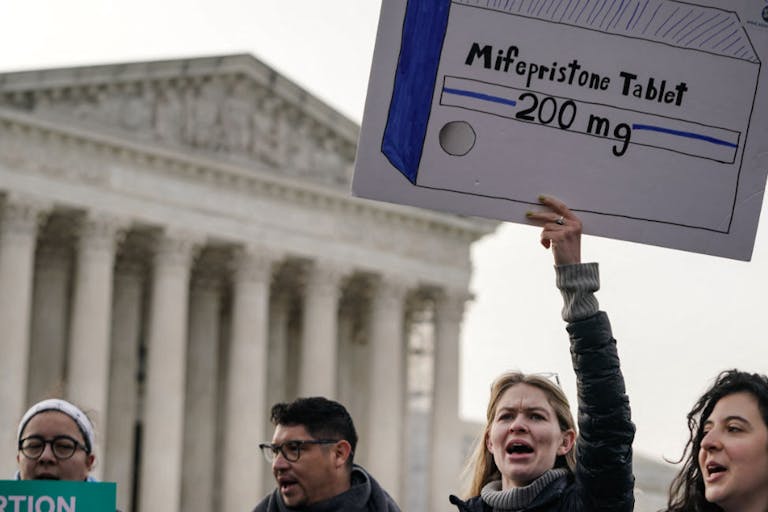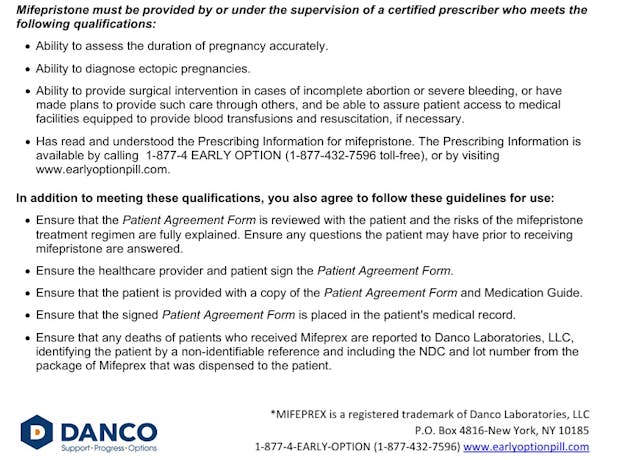
Pro-abortion critics slam Gwen Stefani for partnering with Catholic Hallow app
Nancy Flanders
·
Abortion Pill·By Carole Novielli
Four states want FDA to excuse them from following abortion pill safety protocols
The states of Massachusetts, California, New Jersey, and New York have petitioned the U.S. Food and Drug Administration (FDA) to remove the REMS safety requirements put in place to monitor adverse events of the abortion pill (mifepristone).
The moves comes as Health and Human Services (HHS) Secretary Robert F. Kennedy Jr. (RFK) signaled a review.
The abortion pill “record” — including the “experts” who originally reviewed the drug — have been kept secret from the American public, so any pro-abortion bias involved in the approval decisions is unknown.
Big Abortion has executed a scheme to hide abortion pill complications for decades, potentially impacting FDA decisions.
The Petitioner States seeking to be released from following safety protocols ultimately want increased access to abortion.
The states admit that most of their abortions are already committed by pill, yet they claim the REMS safety protocols are “burdensome.”
The states go so far as to claim that known risks associated with the abortion pill aren’t caused by the pill, despite the FDA’s mifepristone label and other studies showing otherwise.
REMS is a safety system to monitor adverse events or complications of a very limited number of drugs that have shown to be dangerous. Mifepristone (200mg), approved by the FDA in 2000 as the abortion pill for use in a regimen with a second drug (off-label) called misoprostol, was placed under the REMS after serious adverse events resulted in the deaths of multiple women.
The FDA defines REMS as:
a drug safety program that the… FDA can require for certain medications with serious safety concerns to help ensure the benefits of the medication outweigh its risks. REMS are designed to reinforce medication use behaviors and actions that support the safe use of that medication.
Abortion pills have a black box warning on the label for risk of hemorrhage, sepsis, and other life threatening conditions.
FDA’s REMS website states that the goal is “to mitigate the risk of serious complications…” by:
Requiring healthcare providers who prescribe mifepristone to be certified…
Ensuring that mifepristone is only dispensed by or under the supervision of certified prescribers, or by certified pharmacies on prescriptions issued by certified prescribers.
Informing patients about the risk of serious complications associated with mifepristone.
Currently the full REMS includes a patient agreement, prescriber agreement, and pharmacy agreement.
1. The pro-abortion states want all safety protocols removed — just for them.
Their citizen petition seeks to (emphases added):
… remove the current shared system risk evaluation and mitigation strategy program, known as the Mifepristone REMS Program, for Mifeprex and its generic, Mifepristone Tablets, 200 mg…
Alternatively, Petitioner States ask FDA to exercise its discretion not to enforce certain aspects of the Elements to Assure Safe Use — specifically, the Prescriber Certification, Patient Certification, and Pharmacy Certification elements — in Petitioner States given the rigorous regulations already in place around the practice of medicine.
To support their petition, the States cite pro-abortion organizations masquerading as unbiased medical groups — such as the American College of Obstetricians and Gynecologists (ACOG) — as well as studies authored by pro-abortion heavy hitters, some of whom might be on the payroll of the manufacturer or funded by abortion pill investors.
2. The states admit the majority of abortions there are already done by abortion pill, yet they claim the safety regulations are “burdensome.”
The states note that “Medication abortion is the primary means by which patients access abortion in the Petitioner States,” listing the following percentages for abortions done by abortion pill in 2023:
Massachusetts: 65% of abortions
California: 71% of abortions
New York: 58% of abortions
New Jersey: 57% of abortions
The REMS has been in place through multiple pro-abortion administrations, and clearly the majority of abortions in the Petitioner States are done by pill — yet they claim the requirements are “unnecessary, duplicative, and burdensome.”
They claimed the abortion pill has a “well-established, 25-year safety record,” making current restrictions “no longer justified by science or law, particularly in the Petitioner States where the right to abortion is legal, protected, and comprehensively regulated by state law.”
Despite these states’ shield laws (which protect abortion providers instead of women), virtually zero abortion regulations, and abortion pill stockpiling, the states claimed they have “robust legal and regulatory protections in place to rigorously oversee the medical professions, maximize patient safety, and ensure informed consent,” and therefore, shouldn’t be held to the pill’s safety rules.
At a time when concerns are growing over the drug’s stability when sent by mail, the states want FDA to remove the drug’s Pharmacy Agreement, previously detailed by Live Action News.
But the real motive is to transform the medical profession into ‘abortion providers’:

For all the talk about “robust regulatory practices” in the Petitioner States, the fact is that the abortion industry already isn’t following most of the safety protocols; Big Abortion has been openly flouting the REMS for decades.
The March 2023 REMS seem entirely reasonable — especially given that these states claim to provide such exemplary medical care. The REMS require that a certified prescriber of mifepristone must be able to:
… Assess the duration of pregnancy accurately
… Diagnose ectopic pregnancies
… Provide surgical intervention in cases of incomplete abortion or severe bleeding, or to have made plans to provide such care through others
… Assure patient access to medical facilities equipped to provide blood transfusions and resuscitation, if necessary.
In addition, a prescriber must make sure that the “Patient Agreement Form is reviewed with the patient and the risks of the mifepristone treatment regimen are fully explained.”

1. Not properly dating pregnancies and not limiting use of the drug to confirmed pregnancies.
Article continues below
Dear Reader,
Have you ever wanted to share the miracle of human development with little ones? Live Action is proud to present the "Baby Olivia" board book, which presents the content of Live Action's "Baby Olivia" fetal development video in a fun, new format. It's perfect for helping little minds understand the complex and beautiful process of human development in the womb.
Receive our brand new Baby Olivia board book when you give a one-time gift of $30 or more (or begin a new monthly gift of $15 or more).
The FDA has approved the abortion pill up to 10 weeks/70 days gestation, but Big Abortion advertises the abortion pill into the second trimester and is pushing to have it used in the third trimester.
2. Not doing proper testing before giving out the pill.
The “no-test” abortion pill protocol removes testing, blood work, and labs and often does not diagnose potentially dangerous ectopic pregnancies, prompting pro-abortion doctors to warn ER staff that they may see more undiagnosed ectopics.
3. Not spending enough time reviewing risks with abortion pill clients.
It is doubtful most mention the drug’s serious black box warning. Instead, they falsely tout the drug as “safer than Tylenol” while pocketing profits.
4. Not providing continuity of care.
The abortion industry advises women to present to the ER and claim to be experiencing a natural miscarriage — a scheme to hide abortion pill complications.
Some conducting clinical trials to expand use of the abortion pill have suggested that emergency room staff should lie to cover adverse events. This fraudulent scheme keeps prescribers in the dark so they do not have to report complications up the chain, and it makes the abortion pill appear safer than it really is.
As documented by Live Action News, prior to 2016, prescribers of the drug were required to report all adverse events to Danco (the manufacturer) which then reported them to the FDA. Since that time, they’ve only had to report deaths.
The Petitioner States deny what is printed in black and white.
Lie #1: It’s not the abortion pill that causes women to hemorrhage; that’s just how abortion is.
Mifepristone’s 2023 label contains a black box warning and states that 2.9-4.6% of women who take abortion drugs end up in the ER (indicating potentially tens of thousands of abortion pill-related visits annually), and the FDA’s medication guide notes as many as seven percent (7%) of women will need surgery after ‘to stop bleeding’ or complete the abortion.
Yet, the Petitioner States claim, “the risk of heavy bleeding is not caused by mifepristone; rather, it is the pregnancy termination that may lead to heavier than normal bleeding in some patients,” and:
There is no evidence that mifepristone requires long-term therapy or threatens serious adverse events immediately after administration…. mifepristone itself does not cause serious infection. Any risk of serious infection arises from the termination of pregnancy, not from mifepristone…

Abortion pill Black Box warning and medication guide suggests sending women to ER
Lie #2: There’s no scientific data showing that the abortion pill isn’t safe or effective.
“No scientific data has emerged that alters the conclusion that mifepristone is safe and effective,” the pro-abortion states claim, dismissing an insurance claim analysis published by the Ethics and Public Policy Center (EPPC) — which states that nearly 11% of women experienced potentially serious or life-threatening adverse events after taking mifepristone — in part, simply because “EPPC is a staunch advocate against abortion.”
But new research from Ireland also seems to confirm this rate of risk.
Though conflicts of interest among abortion pill study authors, trial sites, and journals are prolific — with some even funded by the manufacturers or investors in the drug — the states have chosen to overlook this.
What the states really want is open, unregulated abortion access.
The states argue that the abortion pill’s safety protocols “interfere[] with the practice of medicine” because they restrict who can prescribe the drug, but for decades, the abortion industry has expected to be treated differently than actual medical providers, fighting regulations and oversight that would hold them to the same health standards.
Bad Actors of Big Abortion continue flouting FDA’s safety requirements, while those tasked with policing them are the ones profiting, namely manufacturers Danco Laboratories and GenBioPro. These violations continue along with secrecy, as even the number of prescribers was considered “confidential commercial information… not publicly available from FDA” when Live Action News sought this information. Yet, the Petitioner States claim there are “dangers” to becoming a “certified” prescriber under the REMS.
But the truth finally came out in the petition, when the states admitted their real reason for opposing the REMS.
“Prescriber Certification perpetuates the stigma associated with prescribing mifepristone, which can discourage clinicians from offering it,” they wrote. “By deterring providers from offering mifepristone, the Prescriber Certification necessarily reduces access to early and safe abortion” (emphases added).
Live Action News is pro-life news and commentary from a pro-life perspective.
Contact editor@liveaction.org for questions, corrections, or if you are seeking permission to reprint any Live Action News content.
Guest Articles: To submit a guest article to Live Action News, email editor@liveaction.org with an attached Word document of 800-1000 words. Please also attach any photos relevant to your submission if applicable. If your submission is accepted for publication, you will be notified within three weeks. Guest articles are not compensated (see our Open License Agreement). Thank you for your interest in Live Action News!

Nancy Flanders
·
Abortion Pill
Carole Novielli
·
Abortion Pill
Bridget Sielicki
·
Abortion Pill
Bridget Sielicki
·
Abortion Pill
Nancy Flanders
·
Abortion Pill
Carole Novielli
·
Human Rights
Carole Novielli
·
Abortion Pill
Carole Novielli
·
Investigative
Carole Novielli
·
Investigative
Carole Novielli
·
Abortion Pill
Carole Novielli
·